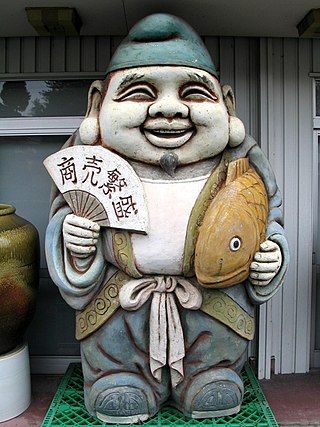Susanoo, often referred to by the honorific title Susanoo-no-Mikoto, is a kami in Japanese mythology. The younger brother of Amaterasu, goddess of the sun and mythical ancestress of the Japanese imperial line, he is a multifaceted deity with contradictory characteristics, being portrayed in various stories either as a wild, impetuous god associated with the sea and storms, as a heroic figure who killed a monstrous serpent, or as a local deity linked with the harvest and agriculture. Syncretic beliefs of the Gion cult that arose after the introduction of Buddhism to Japan also saw Susanoo becoming conflated with deities of pestilence and disease.

The Meitei script, also known as the Kanglei script or the Kok Sam Lai script, after its first three letters is an abugida in the Brahmic scripts family used to write the Meitei language, the official language of Manipur, Assam and one of the 22 official languages of India. It is first known from engravings on 6th century CE coins and copper plate inscriptions. as verified by the various publications of the National Sahitya Akademi. It was used until the 18th century, when it was replaced by the Bengali alphabet. A few manuscripts survive. In the 20th century, the script was revived and is again being used. Beginning in 2021, the Government of Manipur began to use the Meitei alongside the Bengali-Assamese script, per the Manipur Official Language (Amendment) Act, 2021.

Shinto is frequently a theme in Japanese popular culture, including film, manga, anime, and video games. Shinto has influenced Japanese culture and history and as such greatly affects pop culture in modern Japan.

Meitei literature, also known as Manipuri literature, is literature written in the Meitei language of Manipur. An ancient institution of learning, the Luwang Nonghumsang, later known as the Pandit Loishang, collected sources of indigenous Meitei knowledge and philosophy until the 18th century. Writing by Meiteis is assumed to go back to the Kingdom of Kangleipak in the early 12th century. The Meitei script is a Brahmic abugida. It is known only from the Puya manuscripts discovered in the first half of the 20th century. Manuscripts of the 18th and 19th centuries were written using the Bengali alphabet. The existence of the Meitei script in the 15th-century hinges on the authenticity of an inscription dated to the reign of Senbi Kiyamba. The first printed Manipuri book, Manipurer Itihas, appeared in 1890 from the Baptist Mission Press, Calcutta. Though the kings of Manipur had established contact with the British from the middle of the eighteenth century onward the real impact of the contact came much later. Johnstone Middle English School, based on the western system of education, was started in 1885 at Imphal, and in 1891 Manipur lost its independence to the British. British domination facilitated the introduction of new systems in the civil, political and educational spheres, which hastened the process of modernization in Manipur, exposed as it was to new ideas and influences.

Pakhangba is a primordial deity, often represented in the form of a dragon, in Meitei mythology and Sanamahism, the indigenous religion of Manipur. He is depicted in the heraldry of Manipur kingdom, which originated in paphal, mythical illustrations of the deity. It is believed that the ancestor of one of the Meitei clans manifested himself as the Pakhangba.

Sabitri Heisnam is an Indian stage actor and one of the notable theatre personalities in Manipuri theatre. She has also acted in the critically acclaimed short film, Scribbles on Akka (2000), directed by Madhusree Dutta, which won the IDPA Award, best script award at Shanghai International Film Festival and the National Film Award for Best Anthropological Film. She is a recipient of the Sangeet Natak Akademi Award of 1991. The Government of India awarded her the fourth highest civilian honour of the Padma Shri, in 2008, for her contributions to Manipuri theatre.

Poubi Lai was an ancient dragon python, who dwelled in the Loktak Lake of Manipur, in Meitei mythology and folklore. It is also referred to as "Loch Ness Monster of Manipur".

Yenakha Paotapi or Yenakha Paodabi Saijin Polibi, also known as the evil eavesdropper, is an old demoness. Stories often show her as an evil spirit. She lingers around the eaves of roofs in Meitei mythology and folklore of Ancient Kangleipak. She is described as the one who interferes everywhere. Legend says that she could not live with human beings. Instead, she lives like a dog or a jackal, sitting on graves. In some cases, she is depicted as a minor goddess in the Meitei religion.
Yamata Amasung Keibu Keioiba is a Meitei language play, written and directed by Heisnam Tomba. It was produced by the Kalakshetra Manipur. This play weaves together the folktales of the two legendary creatures, Yamata-no-Orochi of Japan and Keibu Keioiba of Manipur.

The ancient legend of Khuyol Haoba and Yaithing Konu is one of the epic cycles of incarnations of Meitei mythology and folklore, that is originated from Moirang kingdom of Ancient Kangleipak. It concerns the fateful love of Khuyol Haoba, an orphan man, for the beautiful Yaithing Konu. Khuyol Haoba was the son of late Khundouremba, a court official of Moirang. Yaithing Konu was the daughter of Luwang Huiningsumba, an influential nobleman of Moirang.

Keibu Keioiba, also known as Kabui Keioiba, is a 2009 Meitei language Indian Manipuri animation feature film, directed by Bhumenjoy Konsam. It is the first Manipuri animation film, based on the Meitei folklore. It was screened in the 11th Mumbai International Film Festival (MIFF) in 2010, under the aegis of the Ministry of Information and Broadcasting.

Lairembigee Eshei, also known as Song of the Nymphs, is a Meitei language play, written and directed by Ratan Thiyam, performed by the "Chorus Repertoire Theatre" of Imphal. It was shown as a closing play at the 21st Bharat Rang Mahotsav at Kamani Hall in Delhi. It was staged on the concluding day of the 9th National Prayas Natya Mela. It was also staged as the concluding event of the three-day State conference on theatre organised by the Network of Artistic Theatre Activists Kerala (NATAK) in Kochi, Kerala.

The Meitei folktales, also sometimes referred to as the Manipuri folktales, are the large collections of folk stories developed from the Meitei culture since Ancient Kangleipak. Folktales are called "funga wari", literally meaning "stories of kitchen furnace or stove" in Meitei language. In early times, in the Meitei households, children must have gathered around the kitchen fire, listening to the stories narrated by the elders. Generally, Meitei folktales were developed from the creativity of the old folks, especially the grandparents, who narrated the children the diverse sagas of varying genres.

The old legend of Sandrembi and Chaisra or Sanarembi and Chaisra is a folktale of the Meitei ethnicity of Ancient Kangleipak. It is a story of the clash between two stepsisters, Sandrembi (Sanarembi), the elder, and Chaisra, the younger, born to the same father but different mothers. Sandrembi, the protagonist, is a young lady, living in forsaken environment and in dire circumstances that are changed into a remarkable fortune. She is portrayed as a person having the nature of God like mind.

Thabaton, lovingly called as Thaba, was a lady in Meitei mythology and folklore of Ancient Kangleipak. She had seven elder brothers who took care of her at every cost. She was kidnapped by Keibu Keioiba, a tiger headed man, during the absence of her siblings. After staying at the captivity of the beast for some time, she was later rescued and freed from bondage by her brothers.

Animals have significant roles in different elements of Meitei culture, including but not limited to Meitei cuisine, Meitei dances, Meitei festivals, Meitei folklore, Meitei folktales, Meitei literature, Meitei mythology, Meitei religion, etc.

Meitei cinema, also known as Maniwood, is the segment of Indian cinema dedicated to the production of motion pictures in the Meitei language, widely spoken in the state of Manipur. The popular term Maniwood, is a portmanteau of "Manipuri" and "Hollywood".

Kumcha Lempi, also known as Kumja Lembi, is a woman in Meitei mythology and folklore of ancient Kangleipak. She is known for being a victim of an attack by a tiger in Khoirentak. Her tragedy is frequently mentioned, narrated and retold in the Moirang Kangleirol legends, usually by the Pena playing balladeers till present times.

Japanese people and Meitei people have a long history of sharing and interacting with each other's art and cultural heritages, including but not limited to cinema, music, mythology, language, literature and theatre.

Pebet is a bird species mentioned in Meitei mythology and folklore of Kangleipak . It was believed to be a small sized bird, smaller than a sparrow. It was believed to be almost extinct.


















